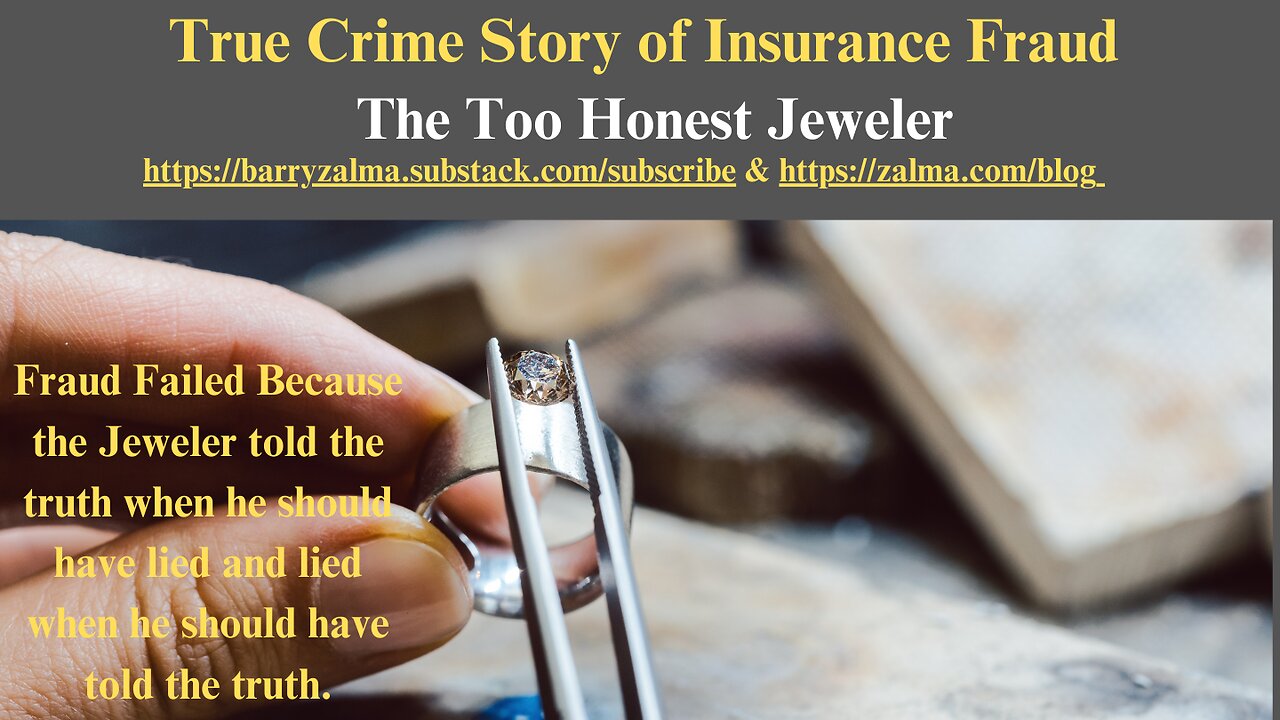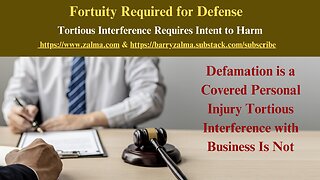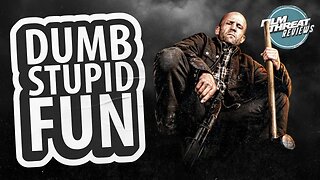Premium Only Content

True Crime Story of Insurance Fraud
he Too Honest Jeweler
Post 4997
See the full video at and at https://youtu.be/LR-rG-QMOR4
by Barry Zalma, Esq., CFE
This is a fictionalized true crime story of insurance fraud explaining why insurance fraud is a “Heads I Win, Tails You Lose” situation for insurers. The story that follows is designed to help everyone understand how insurance fraud in America is costing everyone who buys insurance thousands of dollars every year and why insurance fraud is safer and more profitable for the perpetrators than any other crime.
The jeweler had learned to cut diamonds in Antwerp. For ten years he worked in a small office grinding facets onto stones of half a carat or less. The boredom of the job infuriated him. He had no future.
He decided to immigrate to the United States where he could use his skills. He turned his savings into small diamonds which he purchased below wholesale from the marketplace in Antwerp. He started business immediately upon arrival, trading diamonds in the Los Angeles wholesale market. His knowledge as a cutter allowed him to make profitable trades and sales.
He came to the United States on a tourist visa. He knew that the only way he could become a legal permanent resident was to have a business in place. The income he derived from his sales was sufficient to allow him to live in Southern California, but not set up a business. He needed a large influx of cash.
After only a month working the wholesale jewelry market, the jeweler learned about insurance. It seemed to him that when they weren’t talking about gems all jewelers spoke about insurance. It was expensive. The insurers required them to install sophisticated alarm systems. The insurers required them to install safes that far exceeded any need of reasonable security.
Other, less honest, jewelers used their insurance company to make a bad year into a good year. Cheating an insurance company, they explained, is simple. The insurance company would accept whatever books and records a jeweler gave them. Thus, not marking sold on an item in an inventory book, he could sell a gem twice. First, it is sold to the customer. Second, when the jeweler reports a loss, robbery or burglary it is sold to the insurance company since it is still noted in his inventory as being present to steal.
The jeweler saw insurance as a way of setting up a permanent business and becoming a legal resident of the United States.
He got from his jeweler acquaintances the name of an insurance broker who asked few questions. He contacted that broker. He told the broker that he was a diamond salesman who operated his business from his home. The broker presented an application to Underwriters at Lloyd’s, London since no American markets would accept such a risk. The Underwriters at Lloyd’s refused to insure the jeweler because he had insufficient security at his apartment.
The jeweler was undaunted. He went to another insurance broker. This time he described his business premises as the location of one of his acquaintances. He put on the new application the address of the acquaintance. He also included the type of safe at the acquaintance’s premises, the type of alarm system and all other security devices of the premises. The jeweler described his inventory as $100,000 in loose diamonds.
The jeweler knew, but did not disclose to the insurer at the time he bought the policy, that his inventory consisted of many very small diamonds whose values totaled no more than $10,000. He created an inventory book describing $100,000 in diamonds by merely placing one or two 0’s after the total carat weight of the diamonds he had in inventory.
The broker submitted the proposal to three insurers, including the RLI Insurance, Chubb Insurance and Protection & Indemnity Company of Puerto Rico who was the only insurer willing to insure him. He was pleased to accept that policy.
One month later, he reported to Jewelers Protection & Indemnity Company that he had been the victim of an armed robbery. He had an appointment with a retail jeweler in Cerritos, California to show his loose diamonds. The jeweler arrived in Cerritos early and stopped at the local Denny’s to have lunch. He had all of his inventory in a small leather pouch in his inside coat pocket. It was a warm spring afternoon. When he pulled into the parking lot of Denny’s Restaurant, his window was rolled down. As he turned off his engine he looked to his left and saw a black man holding a chrome-plated pistol. The pistol pointed at the jeweler’s mouth. The black man demanded his wallet. The insured complied. The man instructed the insured to put his hand on the dash and his face on the steering wheel. Frightened, he did as they told him.
The black man than reached into the window and struck him across the forehead with the pistol. The jeweler was unconscious for a short time and awoke with his head slumped against the steering wheel. The thief must have reached into his coat pocket because the pouch containing the diamonds was gone.
The loss was highly suspicious. The insurer’s adjuster noted multiple red flags or indicators of insurance fraud:
It came soon after the policy was issued.
It happened in a way that appeared to be physically impossible.
The bruise was on the right side of the jeweler’s head.
It seemed that the armed robber would have had to reach in across the insured’s face and then double back with his pistol to strike him as described.
The insurer retained counsel to examine the jeweler under oath. The jeweler, on the recommendation of his insurance broker, retained counsel to represent the insured’s interest. Counsel for the insured became quite bored with the proceedings. The insurer’s attorney, being familiar with the intricacies of a Jewelers’ Block policy and the warranties made by an insured when purchasing a Jewelers’ Block policy, inquired in copious detail about each statement made in the proposal for Jewelers’ Block insurance. The insured responded to each question thoroughly. The Insured delayed his responses, however, because of the need for a French language interpreter that allowed him to hear each question twice, once in English and then again in French.
The insured’s counsel, well over sixty years of age, could take it no longer. He fell asleep on the sofa in the office of the attorney for the insurer. While the insured’s counsel slept, the insured admitted that he operated his business from his home. He also admitted that he did not have an alarm system in the home that he did not have a safe in the home and that he did not do business at the location specified on the proposal. Rather, it was the business location of a friend who would occasionally let him store his inventory in the friend’s safe.
Counsel asked, when faced with these truthful responses, why the insured had listed a business address for his jewelry business when, in fact, he had none. The jeweler explained that when he had honestly reported his business arrangements, he could not get insurance.
Counsel for the insurance company completed the examination under oath shortly thereafter. He awakened counsel for the insured and wished them a good day.
Counsel for Jewelers Protection & Indemnity Company then advised his client to immediately rescind the policy of insurance for willful material breaches of warranty and misrepresentation of material fact.
The testimony by the jeweler clearly established that the jeweler knew that he was not eligible for insurance with anyone, including even Lloyd’s Underwriters, because of a lack of security. The jeweler intentionally and willfully misrepresented the state of his business and security to get the insurance. There was never an an honest and honorable agreement between the insured and the insurer about the risk the insurer was asked to take. The policy was obtained, without question, by fraud.
The insurer agreed and counsel advised the insured’s attorney of the rescission. Counsel referred the attorney for the insured to the line and page number of the transcript of the examination under oath where the jeweler admitted to misrepresentation on the proposal form.
The jeweler met with his lawyer to discuss his future actions. He could not understand why he did not recover $100,000 from his insurance company like his friends had suggested.
The insured’s lawyer, although drowsy, was familiar with the law. He had no intention of becoming a party to a fraud. He explained to the jeweler what he had done, even if done without malice, was sufficient to allow an insurance company to rescind the policy for fraud.
The lawyer explained to the jeweler that his actions were not only wrong civilly, but, in California, an attempt to defraud an insurer was also a criminal offense. If the jeweler was not careful he might be arrested and spend five years in the state penitentiary. He could also be shipped out of the country as an undesirable alien. The lawyer suggested that the jeweler leave well enough alone. The insurance company seemed willing to close out their books without payment and not pursue criminal prosecution. If he upset them, he might find himself facing criminal charges. Finally, because the lawyer knew of the fraud, he made it clear to the insured that he refused to sue for the jeweler.
The jeweler’s attempt at fraud could have been successful. His mistake was not knowing enough about insurance law. His mistake was giving the lawyer for the insurance company facts that enabled the insurance company to rescind his policy. To be competent and effective as a perpetrator of insurance fraud it is necessary to know when to lie and when to tell the truth.
The jeweler did not know. He told the truth when he should have lied. He lied when he should have told the truth.
This article was adapted from my book Insurance Fraud Costs Everyone Available as a Kindle Book and Available as a Paperback from Amazon.com.
(c) 2025 Barry Zalma & ClaimSchool, Inc.
Please tell your friends and colleagues about this blog and the videos and let them subscribe to the blog and the videos.
Subscribe to my substack at https://barryzalma.substack.com/subscribe
Go to X @bzalma; Go to Newsbreak.com https://www.newsbreak.com/@c/1653419?s=01; Go to Barry Zalma videos at Rumble.com at https://rumble.com/account/content?type=all; Go to Barry Zalma on YouTube- https://www.youtube.com/channel/UCysiZklEtxZsSF9DfC0Expg
Go to the Insurance Claims Library – https://lnkd.in/gwEYk
-
 7:57
7:57
Insurance Law
4 days agoFortuity Required for Defense
471 -
 2:01:52
2:01:52
Game On!
18 hours ago $12.10 earnedMarch Madness Final 4 Will Be Set TODAY!
43.8K4 -
 LIVE
LIVE
LumpyPotatoX2
2 hours agoHunt Shadows Family Sunday - #RumbleGaming
504 watching -
 5:04
5:04
Film Threat
1 day agoA WORKING MAN | Film Threat Reviews
19.3K3 -
 22:08
22:08
Misha Petrov
23 hours agoMain Character Syndrome Is Spreading
14.3K41 -
 LIVE
LIVE
DarknessGames
14 hours agoIT'S BACK! - Dark Souls II (Part 7)
84 watching -
 28:30
28:30
CatfishedOnline
1 day agoWoman Wants to Leave BF for Lover or Romance Scam?
18.1K13 -
 LIVE
LIVE
DookiePox
4 hours ago $0.10 earnedGood Morning. Sunday Morning.
48 watching -
 LIVE
LIVE
johnnymassacre
11 hours agoLet's Play Space Marine 2 | ANGEL OF DEATH MODE | Pt 3
175 watching -
 18:07
18:07
Bearing
4 hours agoThe INSANE MENTAL DECLINE of the Democrats 💥 Lefties are NOT Ok
13.7K57